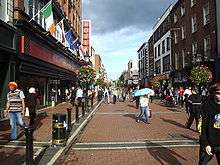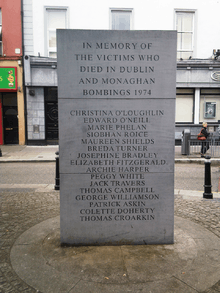Talbot Street
Talbot Street (/ˈtɔːlbət/; Irish: Sráid Thalbóid) is a city-centre street located on Dublin's Northside and is one of the principal shopping streets of Dublin, running from Connolly station and the International Financial Services Centre at Amiens Street in the east to Marlborough Street in the west. The street is named after Charles Chetwynd-Talbot, 2nd Earl Talbot, Lord Lieutenant of Ireland, 1817–21. One of the street's most famous residents was Alfie Byrne, ten times Lord Mayor of Dublin.
 | |
 | |
| Native name | Sráid Thalbóid (Irish) |
|---|---|
| Namesake | Charles Chetwynd-Talbot, 2nd Earl Talbot |
| Length | 550 m (1,800 ft) |
| Width | 18 metres (59 ft) |
| Location | Dublin, Ireland |
| Postal code | D01 |
| Coordinates | 53°21′3″N 6°15′14″W |
| west end | North Earl Street, Marlborough Street |
| east end | Amiens Street |
Streetscape
Talbot House, the offices for the Department of Education, is one of a number of significant buildings. To the east, a street renewal programme has improved the area close to Connolly Station. The editorial offices of the Irish Independent newspaper have relocated to Talbot Street and the presence of a number of financial institutions such as Irish Life & Permanent Plc. and Bank of Ireland have also helped to raise the profile of the street which traditionally has not enjoyed the same level of commercial success as Henry Street to the west of nearby O'Connell Street. The vista looking east along Talbot Street is closed by the impressive edifice of Dublin Connolly Railway Station at Amiens Street with its distinctive Italianate tower at its centre. The station is named in honour of Irish Socialist leader, James Connolly, leader of the Easter Rising in 1916 when commander of the Irish Citizen Army. A statue of Connolly has also been raised in nearby Beresford Place, opposite Liberty Hall, headquarters of SIPTU (Services, Industrial, Professional & Technical Union), the largest trades union in Ireland. The street is a one-way street from going east to west from Amiens Street to Marlborough Street.
History

In October 1920 republican Seán Treacy (also spelt Tracey) of Tipperary was shot and killed outside the Republican Outfitters shop at number 94, having been spotted by British agents on clandestine patrol in the vicinity. A plaque of remembrance marks the spot and is the focus of an infrequent commemoration attended by large numbers of Tipperary people on the morning of the All-Ireland Hurling Final in years when the Tipperary team participate,[1] thus underlying the close association of the Gaelic Athletic Association with Irish nationalism. In the 1930s, 40s and 50s there were a number of attempts to change the name of Talbot street to Seán Treacy street. In 1943, the Dublin Corporation passed a motion urging a change of name subject to the support of the majority of rentpayers on Talbot Street. However, the rentpayers of the street voted not to rename the street.[2] Another horrific event, (part of the Dublin and Monaghan Bombings) of even greater proportions occurred in Talbot Street on 17 May 1974 where one of three car bombs allegedly planted by the loyalist Ulster Volunteer Force (UVF) exploded outside a shoe shop opposite Guineys near the Lower Gardiner Street intersection, killing 13 women and one man. Nobody has been charged with the bombings, despite a campaign of nearly 40 years to find the perpetrators.
Welsh Church
No. 78 Talbot Street (on the corner of Moland Place) is the site of the former Welsh Church or Capel Betel, designed by the architect William Murray,[3] it is now a protected structure.[4] It was a chapel for Welsh people visiting the city, with services conducted in Welsh.[5] Established in 1838 (first service on Sunday 4th of November 1838), its ethos was Calvinistic Methodism, and was affiliated to the Anglesea circuit.[6] The Church was often referred to as the Welch Church, Welsh Methodist Church, Welsh Orthodox Church or Welsh Presbyterian Church. An early Chaplain was Rev. William Griffiths. Rev. John Owen served as chaplain from 1885 until 1894. Rev. John Lewis was the churches minister from 1894 to 1934, he tutored the politician Ernest Blythe, who attended services to study Welsh (as did other members of the Gaelic League. It was decided to close at a meeting in December 1938, and sold in 1944, with proceeds going to churches in Anglesey. The building has subsequently been a Shoe shop(Griffiths), a snooker hall, an arcade and an Internet Cafe.
Shopping Centres
The Irish Life Shopping Mall is a small shopping centre; it has a number of shops spread around a flat shopping mall and is easily accessible from both Talbot Street and Lower Abbey Street. The Centre which is a conglomerate of retail and office space with generous underground parking has a large frontage on Talbot Street. The Car Park for the Irish Life Mall is accessible from Abbey Street, exiting onto Beresford lane and lower Gardiner street.
Retail & services
This list is not exhaustive
- Guineys
- O'Hanrahan Lally Solicitors
- Routledge Doyle Solicitors
- Bertoni Neon
- Cafe Kylemore
- 101 Talbot Restaurant (formerly The American Connection Restaurant)
- Madigan's pub
- Celtic Lodge Guesthouse-Restaurant & Bar www.celticlodge.ie
- The Celt Bar
- Le Bon Crubeen Restaurant
- Insomnia Coffee
- Days Inn Hotel
- Comfort Inn Hotel
- Ripley Court Hotel
- Barrys Hotel
- World-Link (Corner of Talbot and Gardiner Streets)
- Iceland
- Supermac's
- Paddy Power Betting Shop
- Cassidy Travel
- TUI Holiday Store
- Anwar-l-Madina Islamic Centre of Dublin, No. 9.
- Anwar-l-Madina Mosque / Talbot Mosque (Sufi / Bareilvi), No. 4-12. [7] [8]
- Dealz
- Dublin Central Inn
- O'Shea's (Old Morans) Hotel, on the north eastern corner, of Talbot St, and Gardiner St.
References
- "Tipp Will Remember Patriot Sean Treacy On Day Of All-Ireland". Tipperary Star. August 26, 2011. Retrieved 9 January 2016.
- Donal Fallon (April 11, 2012). "Ailtirí na hAiséirghe, Sean Treacy and Talbot Street". Come here to me!. Retrieved 8 January 2016.
- Five Star Internet And Copy Centre, Dublin City Buildings of Ireland.
- Welsh chapel in Dublin awarded protected status www.dailypost.co.uk
- Spittoons for unruly sailors and a congregation which felt the need to carry firearms... the history of Ireland's only Welsh chapel by Sion Morgan Assistant Editor, Wales Online, www.walesonline.co.uk, May 20, 2005.
- Welsh Chuch Talbot Streat Features, Draig Werdd - the Welsh Society in Ireland.
- Mosque on Talbot Street gets go-ahead despite objections by Olivia Kelly, Irish Times, July 21, 2008.
- Prayer Times Talbot Mosque